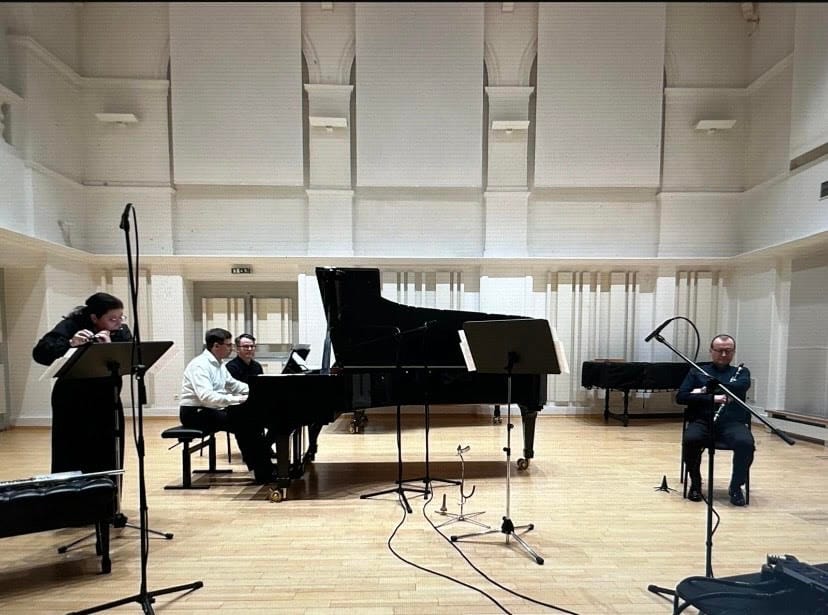
Save Our Souls
VENI Ensemble. Slovenian National Gallery, Bratislava, 11.02.2025
Daniel Matej (b, 1963) Save Our Souls (2015, version for picc/piano)
Sciarrino Let me die before I wake (1982)
Lenka Novosedlkovà (b. 1989) Obraz I (2024)
Adrián Demoč (b. 1985) Trblet (2012, rev. 2024)
Daniel Matej … morceaux en forme de poire (1995): I tried them and they were all ROTTEN
LA Musica 75 (2014, Slovakian premiere)
Lullabies: Točivadlo (1995)
Stockhausen Tierkreis (19784/5, version for flute, clarinet and piano)
Founded in 1987, VENI Ensemble is dedicated to the music of our time via imaginative programming. It is the longest-running contemporary chamber ensemble in Slovakia, and here comprises Ivica Gabrišová (piccolo, flutes); Ronald Šebesta (clarinet, bass clarinet); Ivan Šiller (piano), and Daniel Matej (artistic director). Production was by Juraj Beráts.
Previous to this concert, my experience of composer Daniel Matej and pianist Martin Šiller had been via a disc of Matej’s music coupled with music by Piet-Jan van Rossum (born 1966), released by VENI Ensemble, and of Šiller alone via a disc of music by Juraj Beneš (1940-2004) released by Hudobný fond Slovakia.
The concert began with the premiere of Matej’s Save Our Souls in its version for piccolo and piano; the original was for recorder and piano, a commission from Rajec Musical Spring and premiered in that original version in 2015 by Zuzana Kozárová and Monika Tujvelovà. Matej studied with Louis Andriessen, and his music (in the light of that) is unsurprisingly complex, dissonant, and exciting. Gabrišovà and Šiller were the performers.
Note repetetition might not sound too exciting per se, but Matej gives this an insistent quality, and the piano works with registral extremes to fine effect. As the music branches out into angularity, so charged silences interject. This is virtuoso for both performers: Matej’s demands are high indeed. In terms of stamina, too: an extended passage solely in the extreme high register of the piano (against piccolo repetitions) requires, surely, ultra-high levels of concentration from both. Gabrišová’s rhythmic sense and articulation was textbook, and Šiller is the perfect partner. In other hands this might sound like a composition exercise, or a mere experiment. Here, it blossoms into a valid musical statement. The diminuendo later on, punctuated by star-like interjections on the piano, is remarkably tender, with Šiller’s gently pointillist piano offering a thoughtful close.
A piece for solo clarinet by the ever-stimulating Salvatore Sciarrino next. The title of this piece is in English. Let me die before I awake. Born in Palermo, Italy, in 1947, Sciarrino has always been a free spirit, one whose music most often skirts silence. Written in 1982 for Ciro Scarponi and marked ‘Tranquillo e uniforme’ (tranquil and uniform), the title comes from a book by Derek Humphrey (an American euthanasia advocate). Here, registral extremes occur again, but in a whisper. The player, here, Ronald Šebesta, has to negotiate multiphonics and other extended techniques in such a way that one person creates the impression of two simultaneous sound-fields, high and low. The piece is almost impossibly beautiful and requires total technical control from the player. Šebesta was remarkable: I can pay him no higher complement than to say I prefer his account to that of my previous first place, the characterful Reto Bieri (best known in the UK perhaps for his work with Patricia Kopatchinskaja). Šebesta is even more hypnotic; perhaps the live provenance played a large part. He is also technically astounding. A real highlight.
Here’s Bieri’s performance:
The name of Slovak composer Lanka Novosedlíková (born 1989) was new to me. She studied composition and percussion at the Bratislava Conservatory and pursued composition at the Bratislava Academy for Performing Arts under Vladimír Godar and Marián Lejava; she has been profiled by the Prague Philharmonia alongside another Slovak composer, Jana Kmit’ová (born 1976). Here, we hear Novosedlíkovà’s Obraz I (Image I) for flute of 2024. Gabrišovà again, this time on flute, full-toned, expressive. Novosedlíková’s piece is markedly more approachable than the Sciarrino, although there is a passage of insistence on one motivic cell that beings back to mind Matej’s piccolo piece (while multiphonics invoke Sciarrino).
Composer Adrián Demoč i(bon 1985) studied with František Emmet at Brno. There is an interesting interview with him on the label Another Timbre‘s website here (along with links to YouTube excerpts of his music). The piece here is called Trblet (Slovakian for ‘Glitter,’ of ’Glint’), for flute and clarinet. Šebesta and Gabrílová work supremely well together here, the clarinet actively disruptive against the flute’s slowly oscillating plane. At other times, the one hands the melody to the other like seamless relay runners.
Here’s a little bonus for our readers at both The Watchman and Classical Explorer: the superb pianist Jonathan Powell gives the World premiere of the piano version of Demoč’s 2019 piece, Ma fin est mon commencement given at the Levoca Festival in 2021:
The pre-Stockhausen part of the concert returns rather nicely to more music by Matej, firstly a piece that was part of a project on Satie’s Trois Pièces en forme de Poire (Christoper Fox contributed his Paired Off to that project, incidentally: link to video of Ian Pace’s performance on Metier). The piece, “I tried them and they were all ROTTEN” has a simplicity and yet is uncompromising, and in that sense it reminds me of some of the piano works of Cornelius Cardew. A lullaby for clarinet and piano has a sort of insistence about it: Andriessen-fed Minimalism, perhaps. Finally of the Matej pieces, a present to Andriessen on his 75th birthday, LA Musica is heard in its version for piccolo and bass clarinet . Matej revels in the pitch difference between the two woodwind instruments. It is more turntable (as its title implies) than lullaby, for sure ideas evolve headily.
The German word Tierkreis means ‘Zodiac’. Originally for music boxes as part of the ‘musical fable’ Musik im Bauch (Music in the Belly, 1975, Stockhausen 41), Tierkreis (Zodiac, 1975, Stockhausen 41 ½ ) is heard here in a version for flute, clarinet and piano. One can easily hear the child-like melodies (no wonder it is Stockhausen’s most popular piece!). The opening ‘Wassermann’ (Aquarius) is charming, a lullaby with just an edge to it. (try the German radio ensemble’s performance on Wergo, a realisation for six improvisers’ to hear a completely different take, although both are recognisably the same piece. Just ). As February 11, the date of the concert, sits within Aquarius, this was the proper starting movement. Pisces next (‘Fische’; it is the sign of the fish after all). This is nice and, er , fluid, Šiller’s piano nicely active against the clarinet’s melodies (if you want to hear a properly submarine performance though, try that on by Dominik Susteck, organ, a live performance from Cologne in 2008 ):
Aries next (’Widder’ in German), an appropriately bullish (or is that ram-ish) opening: Šebesta is superb in this movement, with Šiller reacting beautifully, Taurus (‘Stier’) features darkly ponderous low piano (Stockhausen-does-late-Liszt) preparatory to bass clarinet in equally ponderous mode. Hints of the lullaby of Aquarius act as a catalyst for change and more activity. Just as the music gets playful, it is ripped away from us to cede to flute and …
… Gemini (‘Zwiling,’ which literally means ’Twins’). Gabrišová is superb here; one can imagine her channeling her inner Kathinka and on-stage in one of the Licht operas (indeed, Sockhausen does reference Tierkreis in Donnerstag). Šiller, when he takes the limelight, with flute offering low-register comments, is similarly congruent with this music. There is the sense of complete immersion and complete alignment from all players. Šiller gives the impression of skllled jazz improvisation (Stockhausen was a fine jazz pianist, remember) before Gabriśová joins him in Cancer (Krebs), a performance of unutterable beauty imbued with the spirit of the dance. The octaves do indeed imply an organ realisation of this works (a indeed Susteck in his Wergo recording proves it does).
Leo (Löwe) is quite a playful beast here (clainet and piano), perhaps the piano’s left-hand sequences implying an underlying threat if one ‘disturbs the beast’. Šebesta certainly gives his all in presenting the lines with force towards the end, thus offering maximal contrast with Gabrilová’s Virgo. This is the finest performance of Virgo I have heard; it comes closest in spirit to that on recorder and guitar by Jans-Martin Linde and Konrad Ragassnig (Wergo) but takes the intimacy just that bit further. How I wish this movement was longer! Here’s Linde:
In a sense, presenting Libra (‘Waage’ – scales – for flute and piano) next does a variant on that; a gentle dance. Gabrílová and Šiller offer a gentle lilting experience.
So how to put a sting in the music’s tail? Where’s the twist in this celestial/bestial tale? Scorpio (‘Skorpion’) is here for clarinet and piano, with Šebesta offering wild glissandos and wailing up in his extreme upper register. Petulant pointillism adds another layer befoe the clarinet’s final, dismissive gesture.
Penultimately (for the star signs …) here is ‘Schütze” (which means ‘Archer’ and indicates Sagittarius). Šebasta again, but this is a true partnership of equals between clarinet and piano, brilliantly realised. The sense of freedom, of vivacity, is palpable. Finally, a goat: Capricorn (‘Steinbock’), performed on piccolo by Gabrisová. It works perfectly as a finale; capricious. There is an almost Messiaen-moment when the piano takes the foreground and the piccolo sings around it in decidedly avian fashion.
This particular performance brings us full circle, though, with a performance of the Aquarius theme. The year is over, another begins; the wheel has turned.
There is an especial poignancy to Tierkries, as Stockhausen was orchestrating the pieces at the time of his death. The night before he passed,, he finished Fünf weitere Sternzeichen, leaving only two unorchestrated numbers: Cancer and Leo.
You can hear the Fünf Sternzeichen of 2004 here (from 24″19), a live performance by the Orchestre symphonique McGill de Montréal, orchestrations of Virgo, Libra, Scorpio, Sagittarius and Capricorn; prior to that on the video is a performance of Tierkries in the 1977 version for chamber orchestra by what credited as “Sinfonia Musicians of Orchestra London Canada”:







